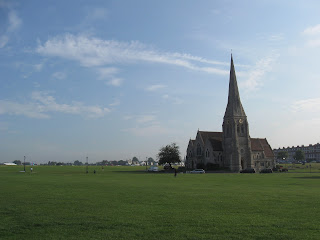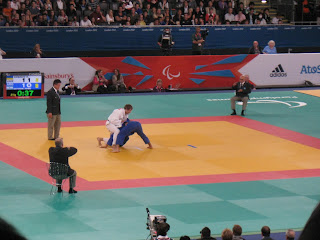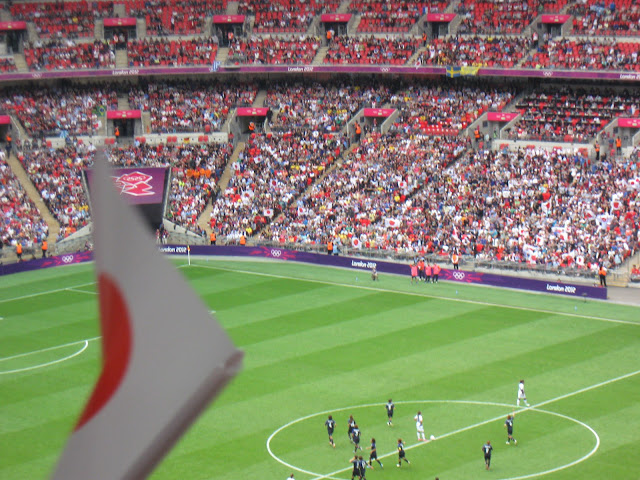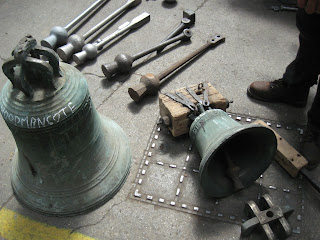Hiya! Me and some friends went to watch the Olympic opening ceremony at UCL. They have a big screen set up there broadcasting from 10 am to 10 pm because they are one of the official partners or something like that. They even get banners on the front of the portico!
During the opening ceremony, there was a flyover of the Stratford stadium by the Red Arrows (the Blue Angels of the UK). We saw them on the tv, and then about thirty seconds later we heard the roar of their engines and I managed to snap the above photo before they went by. Pretty neat!
The next morning, I went to Whitechapel to see the famous bell foundry! I was nervous about taking the tube in case the Olympic / tourist crowd was nuts, so I spent about 50 minutes riding the Overground all the way through north London before dropping down into Whitechapel. I was surprised, it wasn't particularly crowded, even on the part of the line that connected with the Olympic Park, so that was a pleasant discovery. The Olympic Committee and Travel for London have been working for several months on a scare campaign and therefore nearly all schools and businesses are requiring their employees to work from home wherever possible. Aldgate was like a ghost town when I was walking around!
Below is the bell foundry as seen from the side. It shares a main road with the East London Mosque / Centre, and every time I have been there I have heard a muezzin singing a call to prayers, which is very cool. There are also a lot of interesting clothing stores and Halal Fried Chicken shops along the street. I like it during the day, but it is the only place in London that I've not been thrilled about by night, although the Royal London Hospital is only a few blocks away, so that's convenient.
Here's the bell foundry from the front! There used to be two doors, but this smaller one is now used as the main entrance. The foundry is London's oldest manufacturing company. Trivia of the day.
Here are some unincorporated bells out for display. By unincorporated, I mean that they do not belong to a set, but they would work well for a church that only needed one bell for their tower.
This is a Burmese bell that was sent to the foundry as scrap to melt down, but they set it aside and kept it. Close call!
The foundry had two locations before they found their current digs. They started up by Aldgate and moved around there twice before shifting a few blocks to Whitechapel, where they set up in an old inn, the Artichoke. This photo is from the inn's courtyard, and the lead water tank remains where they found it, perhaps a little more colourful!

Although the tour was not supposed to be guided, the employees were all very friendly and so I got to pester quite a few to ask them what they were doing. The man below is coating the inside of a cast with loam. Once he has built up enough, he will spin a frame / pattern (sorry, I don't remember all the technical words) around to make sure the loam is traced perfectly, at which point the whole cast will be upended and placed over an interior mold that has undergone the same process. The outer and inner casts, once fitted, will have a space in between where the molten mix of metal can be poured. {/\} <- dunno if that visualisation helps you or not, haha.
Below, the pattern for Big Ben on the far left, and two of its accompanying bells. Then, the next largest on the right is the pattern for the bell at the Olympic Stadium, and I have forgotten what the bell on the far right is, sorry!
Before I interrupted him, there was a man cleaning graphite off of the bell on the stand there, but he was more than happy to tell me about the other bells out on the floor. In the back, you can see a number of bells that are part of a 14 piece set being made for a church. The bell on the left in the front is a bell from the 1400s when the foundry first began operating, just in for some polishing and maintenance. He showed me a number of clappers and how the design has changed through history.
Here are a few very old clappers and bells that are several hundred years old as well.
The next employee I came across was the handbell specialist. He was very excited to hear that I went to an AGEHR (American Guild of English Handbell Ringers) event when I was a kid, but I didn't know any of the names he asked me about. His job is to crack open the handbell casts, sort bells into sets, tune, polish, and fit handles and clappers on them, and then ship them off.
Here are some bells, post-tuning, in various stages of polish and leatherwork.
These bells he is just starting on, and they are fresh off the presses, so to speak. He is working on finding bells that "sound" alike to put in the set above there.

There was an employee tuning a very large bell at the next station. He and the handbell tuner had a bit of a rivalry, and the large bell guy jokingly tested one of the freshly tuned handbells and proclaimed it was several cents off of the mark. He showed me how to read the machine on the left, but I'm afraid I didn't really understand it. Basically, all of those red quarter circles have a little glowing line bouncing back and forth. There's one reading for each note in traditional Western music, and every bell speaks with several tones at once. Supposedly, when a bell is approaching specific frequencies, those dials will bounce more than the others, but I didn't really see it. Every time I focused my eyes on one dial, it appeared to bounce more, optical illusion style. My ears were telling me which ones I should be watching, but if I looked at their neighbours suddenly those would be more jumpy than the "correct" ones, so I gave up. He said the bell on the apparatus in this photo weighs about 1.5 tons. The scale isn't apparent here, but it came up to about my shoulders. There bells are tuned by scraping off layers of metal from the inside, and you can see the device they use to do this sitting in the middle of the bell.

However, before they got fancy technology, bells had to be tuned by hand. This bell is old enough that you can see where someone chipped away at the edge there to tune it.
They have an electric carillon / bell tree in the courtyard. They played "Oranges and Lemons" for me as a demonstration, run from a computer. I was really curious to see the notation / program they were using, but they were a bit puzzled and said they basically have a little chip that they insert in and then it plays. Dang, I was excited for a second that I would be able to use my computer music training in real life, haha.
That's the end of my Whitechapel Foundry adventure! Many thanks to Ruth for sending me to the foundry. Give my best to the bell choir at 1st P!
Only one week until I get to go to the Olympics football semifinal!!! I'm excited!


















































